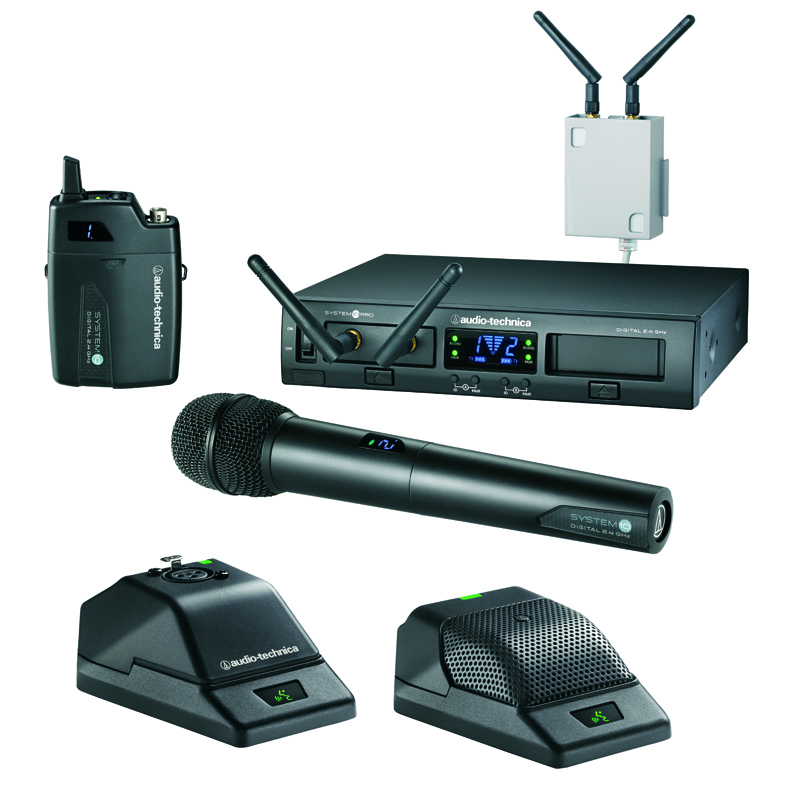Traditional analog FM (UHF and VHF) wireless systems have advantages – such as longer wavelengths (especially with VHF units) and, thus, a more robust signal – but the ongoing U.S. governmental “repacking” of the TV bands in which these systems operate has led to RF spectrum congestion, making it difficult in some areas to find enough open frequencies to operate wireless microphone systems.
As a result, 2.4 GHz digital wireless systems can be a viable option for many users, especially those without the aid of a dedicated tech team.
Some potential users harbor reservations about 2.4 GHz systems in WiFi-rich environments, in places where line-of-sight placement is problematic, and/or where multiple systems are required. Understandably, no one wants to settle for a limited-use system just so they can escape the overcrowding and regulatory uncertainty of the TV bands.
Technical Factors
UHF systems transmit shorter wavelengths than their VHF counterparts and so tend to have fewer problems with interference. Also, since the UHF spectrum is wider than that of VHF, there are more frequencies to choose from, making UHF a better choice when operating in an area where a lot of other wireless systems are present or when wanting to employ multiple systems.
This broad spectrum, paired with frequency-agile systems capable of tuning in anywhere from 10 to 100 channels (or up to 1,000 user-selectable frequencies), has made UHF wireless systems the standard for concert tours, theaters, megachurches and the like, any one of which might employ 50 or more channels of wireless.
To combat the challenges associated with operation in the higher-frequency UHF band, many UHF systems include diversity and companding technology to enhance their performance. Diversity systems employ two receiver paths in order to combat interference such as multi-path fading. The logic inside the receiver chooses the signal path with the least amount of interference.
Companding compresses the audio signal upon transmission and then restores it close to its original dynamic range in the receiver. But while this improves the system’s overall performance, it can also introduce audio artifacts, and, since companding is typically optimized for a specific audio-frequency range, it can be unsuitable for wide-range sources such as bass guitars.
Avoiding The Crowd
But, again, the repacking and auctioning off of spectrum makes the use of UHF TV bands increasingly problematic. A congested UHF band will become even more crowded. Unlike traditional analog VHF and UHF wireless systems, some digital wireless systems operate outside the TV bands, so they avoid all of that congestion.
And while it is true that systems operating in the 2.4 GHz range have to compete with WiFi, microwave ovens and other activity, a digital system with frequency diversity may easily avoid interference by constantly monitoring the spectrum and switching to a better frequency when necessary. (Keep in mind that many 2.4 GHz systems don’t operate with this frequency diversity; however, this widespread deficiency is a primary cause of disenchantment with 2.4 GHz wireless.)
Plus, the digitally modulated signal of these systems removes the need for analog companding, so they can deliver uncompromised, full-bandwidth, high-fidelity audio.
These systems can also incorporate professional features without greatly increasing the cost or making then difficult to use. The new Audio-Technica System 10 PRO rack-mount digital wireless system, for example, offers the aforementioned advantages of a 2.4 GHz system, along with three levels of diversity assurance (the signal is sent on two dynamically allocated frequencies, in two time slots, from two antennas on both receiver and transmitter), allowing it to be taken anywhere, set up and turned on for faultless digital audio.
The System 10 PRO also offers two receiver units that can be removed from the chassis and mounted remotely via basic Category cable (Cat-5e, Cat-6, etc.), plus a unique linking function that allows up to five chassis (10 receiver units) to be synched for simultaneous use.




















